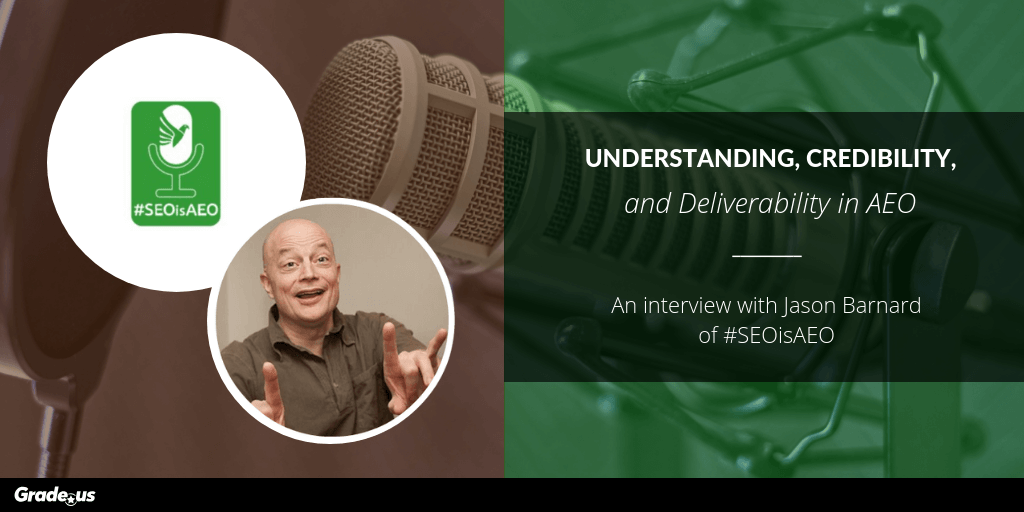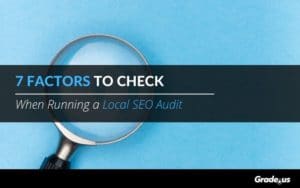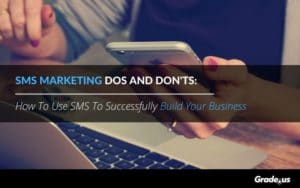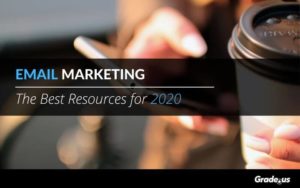You may have heard of Jason Barnard: he's the host of the podcast #SEOisAEO. He's also a contributor to SEMrush and Search Engine Journal. He was a recent speaker at SMX London, and he's on his way to Pubcon Vegas in October.
I'm merely touching on the highlights here.
Jason is full of enthusiasm. He's unafraid to be unconventional. As Google continues to move towards a layout that incentivized zero-click searches, adding ads to SERPs, and becoming the number one competitor for most of your client's websites, then you're going to want to read on.
He's got it figured out.
If you're curious about what "AEO" means, just read on. You're about to find out. I'm not much for making predictions, but I suspect all of us just might be using it in another ten years.
How Jason became fascinated by Google and SEO
Raney: You've gone against the grain in some ways. You've suggested that it's wiser to ignore Google's algorithm in favor of focusing on understanding and credibility.
We should be practically helping Google figure out what you're about and then demonstrating your site is as credible as possible.
How did you come to develop this approach?
Jason: Well, actually, it has changed very slightly. I'll tell you a little story.
I started it 5 years ago. I started working on my own name. I started to look at what came up when you search for Jason Barnard.
I worked for a couple of years trying to feed information to Google to get the Knowledge Graph, the Knowledge Panel, and the results.
The idea was, if I don't control the SERPs, it will give me great insight into how Google functions, both in terms of how it ranks and in terms of how it brings up those rich elements (like videos).
When you search for Jason Barnard, I'm going to make sure the results I want, come up. I want to make sure they're coherent and show me off in my best light.
If you search for my name now, you will see the knowledge panel. You will see videos, because last year I started doing lots of videos just to see if I could get the video pack. I started tweeting last year to see if I could get in the Twitter pack.
I set out to influence the SERP for my own name throughout the world, to both be positive represent me accurately, and to be full of rich elements, full of multimedia stuff.
On Google's intention for understanding an individual
I realized that what Google is looking to do is understand who I am and what I do.
In terms of ranking against other people, evaluate my credibility.
The knowledge graph part and influencing the SERP is all about understanding. It's all about making sure Google understands.
If Google understands, it will present what I want it to present, because it doesn't have any reason to present anything else. If I'm being honest about the information I feed to it, it will provide that information to its users. It will represent me in the way that I wish to be represented.
It has no reason to do otherwise, unless it's got something negative that somebody else is saying about me. At which point, you get into the ORM world.
On measuring the quality of brand SERPs and helping Google understand the brand
I'm actually building a tool that measures the quality of a brand's SERPs.
When you type in a brand, Kalicube.pro, measures the quality of that SERP in terms of multimedia items, in terms of positive reflection of your brand.
I'm absolutely convinced that brand searches are going to be the next big thing that people are going to get completely obsessed about.
Raney: When you say "brand search..."
Jason: When someone searches your brand name what comes up?
The idea there—and I'm going a bit off-topic from what you actually asked me — but if I know who you are, if I'm thinking about doing business with you, there might be journalists, they might be a client, they might be a prospect, they might be a funder, or a potential employee.
They're searching your brand to look at what comes up. They want to research you. So the first thing to do is Google your brand. What comes up on that page is phenomenally important.
It's that first two seconds like walking into a room at a party. You walk into a room, and if you're dressed shabbily you're going to make a shabby impression. It's that same two-second rule.
Google becomes your homepage. Google becomes a representation of you that you can't get away from. So if someone looks for you and they see a review site with 1 star, or they see somebody complaining about your crap service, obviously that's bad. You can't rely on them to dig down and understand. So they're going to look at that SERP and make a snap judgement about you. That snap judgement is very difficult to change once it's there.
In my case, if you search for my name, you think, "Oh, he's an expert in search marketing." He does all these videos. In two seconds, you can see who I am, what I do and the fact that I'm credible.
Any credibility can be found in that first two seconds. There are five star reviews on that first page. I've got my Twitter feed.
My clients have said to me, "Oh, I looked at you on Google, I'm going to work with you, because you're very impressive online."
It's kind of cheating. But it's not. I pull up all the good stuff about me and push it to that first page.When you see the videos, or Twitter boxes, or the knowledge panel, it's all real stuff that I'm truly doing, but I've just chosen my battlefields, if you want to say that.
If I wrote loads and loads of blog articles I would have fifteen pages of blog articles. I do write a few blog articles, but what actually comes up are the profile pages from Search Engine Journal or SEMrush.
Five years ago, I start thinking about understanding. Communicating to Google who we are and what we do. Then I added to that the idea of credibility. I started working with an SEO-savvy review platform. I started working with a client who is incredibly tightfisted and didn't want to invest in a review platform if it wasn't the perfect one. So I went through all of them, sat through all of their sales pitches, and one stood out.
I worked on this idea and did a White Paper with them about SEO. They released it at Brighton SEO two years ago. It was all about anti-Search Engine Optimization and saying:
"What does Google want to do? It wants to bring you the answers."
To do that, it needs to understand who you are. If it doesn't understand who you are and what you do, it can't provide you as an answer.
Once it has understood you, it probably has understood your competition as well. So how does it choose between the two? It chooses the most credible.
We're not looking at Google to provide links anymore. We're looking to provide that answer, which is very powerful as a concept.
We're not looking at Top 10 or Top 3, we're looking at Top 1.
On the transition from an SEO philosophy to an AEO philosophy
Since then, our understanding has evolved further. When I talked to Dawn Anderson of Bertey, she said we're not about Search Engine Optimization, but Assistive Engine Optimization.
I think she's 100% right. Google is an assistive engine.
It doesn't always try to give the answer. Sometimes, for example, if you're researching a product, it gives you what looks like a knowledge panel with the products you're looking for, with reviews and offers and different points of view. You're actually sitting on the SERP with Google, and it's trying to get you to do your research on the page.
It's not giving you an answer. It's giving you a variety of information on a subject that you can then work through on your own. The important part there, two important parts, your own SERP and format/deliverability.
There's a third angle.
You've got understanding and credibility (the articles you read on SEMrush).
I've got a friend who told me "everything has to go in 3s." He teaches A-level students, 17, 18-year olds. He said, "If you give them two, it doesn't seem right to them. If you give them four, they can't remember the 4th. If you give them 3, you always remember them." I said, "Ok, from now on, everything in 3s."
So I sat there thinking, "What's the third one?"
The third one is deliverability.
It needs to understand who you are and what you do.
It needs to think you're credible.
It needs to be able to deliver the content to the users, provide that content that Google can deliver it.
So deliverability could be speed, a blog post, a podcast, a video, maybe an image.
So you've got this concept of deliverability. The simplest example of that is saying: if you don't have a mobile-friendly website, you are not deliverable, and therefore not a candidate to be in the mobile results.
That's your three pillars.
I need to be understood.
I need to be credible, and I need to be relevant to the context.
I need to be deliverable, which means having the relevant content to the context.
When I was in a closed session with Gary Illyes in Sydney, Australia, I asked him if there was a separate algorithm for the featured snippet. He said, "No, there isn't. But this is how it works."
What Google has is a Darwinistic system of rankings. These factors are a value-to-the-user bid. They present a value to the user. Let's say a score of 10,000 or 20,000 or whatever it might be.
Then videos will put in a bit as well. If the top video can outbid that top blue link, it gets a place in the results.
That's how you get the rich results coming in.
They prove themselves to have more value to the user in the context in which they find themselves than the top blue link.
We're evolving towards a multimedia SERP where Google is using artificial intelligence, using their vetting system to create multimedia curated, machine-curated multimedia content in a similar way that Yahoo! is.
If you go to Yahoo!, you've got that multimedia content, videos and etcetera, but it's all done by humans. Google is moving towards that idea of doing machine-curated content based on the specific context of the specific user for the specific query.
On the transition from an SEO philosophy to an AEO philosophy
Raney: So you're encouraging people to get beyond the tunnel vision of that organic search result where you're just looking at the blue links.
Instead, you look at all of the different search results, like the social media and the reviews and all that.
People usually don't. They don't focus there, at all.
Jason: 100%. Absolutely.
This is what I'm telling my clients.
If you write a blog post, which is what people do. It's the knee-jerk reaction:
"Oh, I'll write a blog post."
You're competing for one of those Top 10 spots, or whatever it is. The 10 blue links, against 30 other articles on exactly the same topic. Everybody else has written an article on whatever topic you're thinking about writing. That's very difficult. That's a very difficult battle to win.
So you fight, and you fight, and you fight to win it.
A lot of people don't even bother fighting. They just put it out and hope it's going to rank.
But if you do want to win it, you need links; you need some activity around it.
If you can do a video or a podcast or an image within the context of that query, it brings more value to the user than the blue link would. Google is now putting podcasts in the search results. People are obsessed about formatting for a featured snippet.
But what's a featured snippet?
It's just another "candidate set." So you've got the ten blue links for the SERP. Google is not going to throw them out. It's the basis of what they're all used to. If they suddenly threw them out, they might lose their entire business model. So what they're doing is having the ten blue links slowly evolve away and replacing it with rich content. All that rich content has to do is prove that it's more valuable to the user in that context than the blue link.
That shouldn't be very difficult, because people want video, they want audio, they want quick answers.
As you rightly said: put blue links to one side. Aim to create the rich elements in Google. Give Google the meat that allows it to put these videos, podcasts, simple answers, knowledge panels into their results.
Product comparison is a very good example. The panel with the product comparison; put your content in there.
So isn't that phenomenally exciting?
If you make a video, and you do a transcript, you've hit both!
If you do a podcast and you do a transcript, you're aiming at the blue link, the featured snippet, the video, or the audio.
If you put an image in there you're now serving up images, and Gary Illyes was saying in Australia, "Images, images, images," That's a very, very strong sign. If Gary Illyes is saying, "I'm bored of blue links, now I'm getting excited about images and videos," you say, well, that's where we should be going then, yeah?
On the tactics of an AEO strategy
Raney: So, how does all this fit into "SEO is AEO?"
Is it all about just providing good answers in all these different formats?
Jason: Yeah, it's about providing great answers in the right format, communicating to Google is the basis of it all. Credibility is the basis of Expertise - Authoritativeness - Trustworthiness (E-A-T). I prefer the word credibility, because it covers it all.
EAT is easier because it breaks it down into what you're actually looking to do.
You want trust. You want to prove you're an expert. You want to prove you've got authority.
But it all comes down as a global term for credibility.
I want this person to look at this page, understand who I am, what I do, and think I'm credible. That's it.
If you do that, you've mastered your brand SERP, you've mastered that first last impression if you see what I mean.
I've been influencing the SERP and using the SERP to communicate a message to my potential client."
With my brand SERP, I've got all the elements that I can potentially control.
What I'm trying to do is influence the SERP in my direction. That's all you were ever doing when you were trying to rank. You were trying to influence the SERP to have you at the top.
Now you're saying, "I'm trying to influence the SERP, yeah, to put me near the top, but also to put me in the rich elements that it's putting out there."
So I need to look at my context and look at the rich element that's going to suit this context. If I create quality content, and I'm credible across the board, and I'm deliverable in that context, I can have that place. For me, that's a fundamental shift in my understanding and what I'm trying to do.
On how link building might play into AEO and deliverability
Raney: Yeah, that's huge! Now where does link building fit into this strategy?
Jason: Ooooh!
Raney: Or does it at all?
Jason: Link building is something I never liked. I always thought link building was rubbish, but it's actually because I'm a bit of a snob.
I built a website for kids called Boowa and Kwala, which is a blue dog and a yellow koala, and we did games. It really was good fun.
It was for preschool kids up to like 6 years old. Because the content brought enormous value to the teachers, the parents, the babysitters — they all put links up all over the place. We used to get loads of links, and I never asked for any. So I thought, "That's how you get links."
I felt like calling people up and trying to get a link is rubbish!
Which is terribly judgmental of me.
So once I stopped doing that site for kids, I just looked at link building and thought, "I hate it." I don't like it. It makes me feel icky.
I did a webinar series for SEMrush last year and this year I decided to move on to a podcast. After five months now, I am getting a link a week and a dozen mentions a day. People just give links to me, because the content is interesting.
Because I'm talking to interesting people about phenomenally, passionate stuff that we all find grandly cool and interesting. But also because I'm constantly bouncing up and down like Tigger like Winnie the Pooh in front of people going, "ooh, ooh, ooh, what about this? What about this?"
I'm front and center. It isn't because I want to be front and center, because I'm thinking, "Oooh, I have to be front and center." It's because that's how I am! I think that comes across in my interviews.
I actually talked to John Rivers about this theory of understanding, credibility, and deliverability. And I explained it to him reasonably quickly. He went, "Yeah, makes a lot of sense." And I said, "So, doesn't that just make it — it's all so simple!"
His reply, "Well, simple probably isn't the word."
But for me it is! I look at that and I go, "Shit, it's so simple." I mean it really is.
Raney: Simple, not easy.
Jason: Brilliant! Thank you! Oooh, very good, thank you. You can quote yourself on that!
Raney: We'll transcript this, so I will!
Jason: Figuring out simplicity is an incredibly complex process.
But I spent the last five years researching.Two years ago, I came up with understanding and credibility. Six months ago I added deliverability.
Now I'm looking at content and link building, and thinking, "okay, to do a series of content is the way forward."
Answering, not search engine optimization, is the next big thing. Actually it isn't but that's neither here nor there. Assistive engine optimization is loads better. If I want to own that space, I have to create a body of work that exists there. It can't just be one article. So we created 15 webinars in 15 weeks. We machine-gunned it out there and said, "This is the body of work that's says Anton and Jason Barnard are associated with Search Engine Optimization. That's where this idea of ongoing content strategy for me started to be born.
With the podcast, I needed to create an ongoing content strategy, because I need an audience and to surround myself with my potential clients." The idea there is to say there are 5 Ps, which doesn't stick to my 3 pillars, but there you go.
You need a platform.
You need a public.
You need a personality.
You need perseverance.
And promotion.
You say, "I get my platform." It can be a podcast. It can be videos. It can be videos on YouTube or Vimeo or podcast or Apple. It can be all platforms. I need a public and a people who are actually going to be interested in me, or my product, or my brand, who I will eventually sell to. But I don't sell to them. I bring them valuable content that serves their purpose, not mine, so that I'm bringing them value.
Then you need a personality. That personality simply needs to correspond to the people you're targeting. So if it's a medicine-based product, you need a doctor who is terribly well posed and very knowledgeable.
If it's investment, you need somebody who is very brainy and very good with numbers.
You get the idea. Brands tend to lack personality in their content creation. So think about personalities. What personality corresponds to your brand or will appeal to your public on the platform you've chosen? Once you've done that, you've got the first three Ps.
Then you need to persevere. You need to keep pumping that content out, and that's going to be a big struggle. You need to promote.
On starting from scratch with a new brand
Raney: Let's say you've got a brand new site, brand new brand. They've just launched a company. Where would you start?
Jason: Start at the very beginning! It's a very good place to start, as Julie Andrews sang in The Sound of Music.
With a new brand, if you're looking at digital strategy, where's SEO going now? SEO isn't dying, but it has to become part of an overall digital strategy. It can't live on its own anymore. SEO is doomed to using Google SERPs as visibility for your brand. You're trying to bring in quality visitors who are ready to convert, which makes brand search even more important, because people are going to be seeing your brand all over the place on social media.
Where are people seeing your brand?
On social media, on websites, on articles, on the telly, a flier, whatever it might be. They see you in the SERPs. They search your brand name. They go on to your website and buy.
The SEO's job becomes this on-SERP presence.
If you look at a brand new company with a new site, first thing I would say is "your site is a representation of your brand," not the other way around.
Think about your brand first. Your website is a representation of your brand. Every tweet to your social media accounts are also representations of your brand. When you participate in forums, or you write articles for other people's blogs, or you appear on a newspaper; that's a representation of your brand. All of those are potential touch points for your clients.
And we haven't even gotten to the SERPs yet.
The SERPS are a representation of your brand. Every time you appear in a SERP, it's a representation of your brand. You need to optimize your brand in that SERP.
You're not just saying, "I want to be #1."
You're saying, "I want to be #1 and project the correct image" or "I want to have one of the rich elements, and be able to project more of my image, and more of the video, compared to a blue link."
With Google now having the How To stuff jumping straight to the middle of the video on the SERPs, to see the answer to, "How do I stretch my shoes?"
I got my shoes too small. I looked it up. It showed me a video and I clicked on it and it showed me:
"Stick it in the freezer with an ice bag full of water in it in you stick it in the freezer."
I didn't leave the SERPs to find that. It just jumped to the middle of the video, and the person telling it to me (they didn't brand themselves very well because I got no idea who it was.)
They had a branding opportunity and they didn't take it. Mind you, it would have been rubbish, because it didn't actually work. I did it, I tried it twice. The shoes were just too small.
Raney: Probably just as well, then, that he didn't brand himself very well.
Jason: So yeah, you're looking at the multiple touch points you've got, of which the SERPs is one. Your website is going to represent another.
Your content for example, your blog, video, podcast, whatever. It's going to be off your site. It's going to be on the SERP. If I'm looking at your podcast, it's on iTunes.
It's on Google Podcast applications. Even in the SERPs.
My super-valuable content, I don't need people to visit my site to see the content. What I need to do is push the content out from where they are. Because Facebook, Twitter, LinkedIn, Amazon, Google — that's where you're trying to stop people leaving their site.
Make sure that your content is branded and that your brand message gets across. When people are ready to buy, they're looking for you.
Raney: That makes a ton of sense. That's how people work. How they search. What they're doing.
Jason: The SEO world has to adapt to that. It's not just keywords and links. It was word counting and link counting, but it's not that anymore. It's part of an overall strategy.
We need to think that way, because if our clients are still obsessing about traffic, we're never going to sell to them. Traffic is dropping from Google. So we need to look at this in the wider context, and we need to start showing our clients that the branding on the SERP, all the places we appear, is already an opportunity.
You don't need clicks, you need your name in front of people.
I would say to anybody starting out, think brand, think of the representations online of your brand, think where people are going to be interacting with your brand, and think at what point you want them to visit your site.
You want them to visit your site when they're ready to buy.
Raney: Absolutely.
Jason: Obviously if you can, get them to the site before you've got more of a chance to communicate with them. But that is no longer necessary. It's becoming more and more difficult. You're saying, "Well, how can I deal with that?" And it really is thinking about all those touch points. Thinking of all the representations.
Representations of your brand. They're not channels of acquisition so much as representations of your brand. You're not acquiring them. They're not coming to you. You're communicating with them off-site.
On-SERP, off-site, on social. That's really difficult to measure, and that's the big problem.
On the future of search and AEO
Raney: Yeah, people like metrics. They like KPIs. They like data.
Jason: I like philosophy though. I like talking about it. I love all this theorizing. As you rightly say, my clients go, "Yeah, but where's the money?" But I'm having a good time.
Raney: What's ahead?
You've already accounted for a bunch of multimedia that's already here. What are you looking at that's going to happen one, two, five years from now? And how are you accounting for that? Or do you even need to, given this strategy is looking at what's out there in terms of candidate sets and then saying:
"Okay, I'm going to go over that, and I'm going to create content for that set."
How much do you even have to worry about advancements in multimedia, given your strategy?
Jason: One interesting thing is voice search. We all get caught up in that. It's fun to play with, but when somebody says, "50% of the searches will be voice searches by 2020," it's rubbish.
You have commands. "Call Mom." That's a big chunk. That's not search. That 50% figure people keep throwing around is very misleading. It's not rubbish, but it's misleading. And Stewart Rogers, there's a podcast interview with him about image search and voice search. He makes a very good point. Voice search in public isn't going to happen. You don't say to your phone, in the middle of a bus, "I've got bunions on me feet."
Raney: Well, some people would, but we don't want to sit next to them.
Jason: Exactly! Somebody said that! But image search in public is perfectly reasonable.
Where you take a photo of someone's shoes and say, "I want those shoes, where are they?"
So, voice search is much more private. It's "Call Mom," it's "Turn on the Telly, turn on the sound, turn on the music." "What noise do dinosaurs make," for your kids. Fun, playing stuff. It doesn't make money. Whereas images potentially can.
He also made another good point, which I find incredibly interesting, is the maturity of these technologies, and what he reckons is a 10-year maturity cycle. He says, "Okay, why are images so important today?"
Why have they...what's the word?
Raney: Proliferated?
Jason: Yeah. Basically since the late naughties, cell phones have been absolutely everywhere. People have been snapping pictures all over the place whereas ten years ago, fifteen years ago, there weren't. So image through the mobile phone has matured, and now is the moment. Voice has only been around for two or three years.
Images is somewhere where we can start making money. Microsoft has started implementing it. Take a picture of someone wearing a dress, and you can tell what necklace they're wearing. That kind of technology is very advanced.
The technology for images is ready. The technology for voice isn't, because they don't have the data. Because machine learning (that's where it is all coming from) relies on three things: the ingredients, the tools, and the imagination.
The tools in machine learning, are mathematical formulas. The ingredients are shitloads of data. And the imagination is somebody putting the data together with the mathematical formula. That's the chef.
If you only have two of them, and for example, if you don't have data, which is a problem, you don't have enough data, you can't write machine learning algorithms that can actually perform. It needs data that's been sorted out in some way, manner, or form. Images, we've had the time. They've got so many images. Videos, same thing. They've got YouTube and shitloads of video. They gave a computer a million hours of YouTube and it just went through it, without knowing anything about the world, and figured out what a cat was.
Raney: That's awesome!
Jason: Exactly! Because they've got the data! With voice, we don't have the data, because people aren't talking to their machines so much. Stewart's point about voice search not being public is incredibly powerful.
Some things are just never going to happen because human beings won't do it enough for Google to have sufficient data. It will never be pervasive in the sense we imagine it will be, because it won't be able to break into certain areas of culture and community. So they may never have the data to be able to make it sufficiently intelligent to really serve our purposes.
Raney: It makes a lot of sense.
Jason: Human beings are still going to drive a lot of the uses of these technologies. Doesn't it all seem so obvious and simple?
Raney: Awesome! You've been so insightful, but it's about time to wrap it up.
Jason: Ooh! Let me say one more thing?
Raney: Of course!
On the underrated value of philosophy over practical advice from time to time
Jason: This is one of my bugbears. Everybody asks for practical advice. Working on my podcast, first thing they say is, "There isn't much practical advice."
When I do conference talks sometimes I get turned down because I don't give enough practical advice to the table.
I can completely relate to that, but thinking from a philosophical and theoretical point of view, looking at that overview, for me that's at least as valuable.
Because if you're just in the details all the time, your practical to-do list after seeing a conference, great, you've got something to do. But the overriding, overarching kind of theory and approach, and what it is we're trying to do and what we're aiming to do, is phenomenally important, and my opinion — very much underestimated.
About the Author
Raney C. Hudson
Raney C. Hudson is an independent content consultant with a 10+ year track record in the digital marketing industry.











